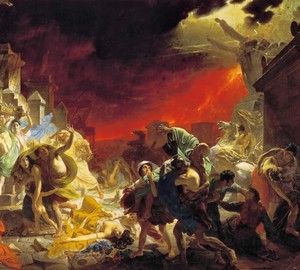
Description of the picture:
The last day of Pompeii is Karl Pavlovich Bryullov. 1830. Oil on canvas. 456.5×651
An outstanding master of historical paintings and portraits, Karl Pavlovich Bryullov (1799-1852) is a vivid representative of the painting of romanticism that painted the era of the first half of the XlX century. He was often accompanied by the epithets “Brilliant Karl”, “Karl the Magnificent”, rarely to whom such glory and recognition of contemporaries fell out. Having received an art education in Russia, Bryullov went to improve painting mastery in Italy.
About the plot of the picture “The Last Day of Pompeii”
The plot of the picture “The Last Day of Pompeii” taken from ancient history – the eruption of the volcano Vesuvius and the collapse of the city of Pompeii (II century BC). The omnipotence of blind rock is a favorite theme of the art of romanticism. The death of people, their confusion and horror before the impending collapse of the city were conveyed by the artist in an interesting and complex multi-figure composition. With theatrical spectacular poses and gestures, various facial expressions, fluttering draperies of clothes, the painter shows the whole drama of the scene, however, despite the impending death, the heroes do not lose their beauty and greatness of spirit even in suffering. This was the philosophy and aesthetics of romanticism. Bryullov’s painting with the inherent rapture of the beauty of form and the solemnity of bright color contributes to the transfer of the pathetic mood of the unfolding action.
After the execution of this monumental canvas, the artist gained European fame. Having moved to Italy at the end of his life, he finally settled there and became an honorary member of the Academies of Arts in Milan, Florence, Bologna and the Academy of Saint Luke in Rome."